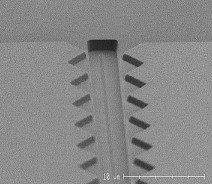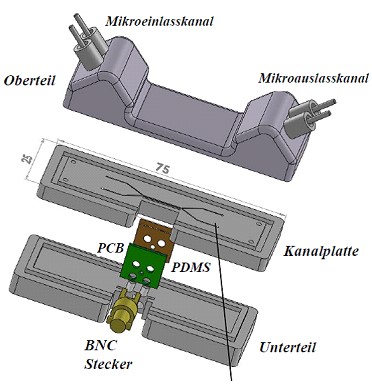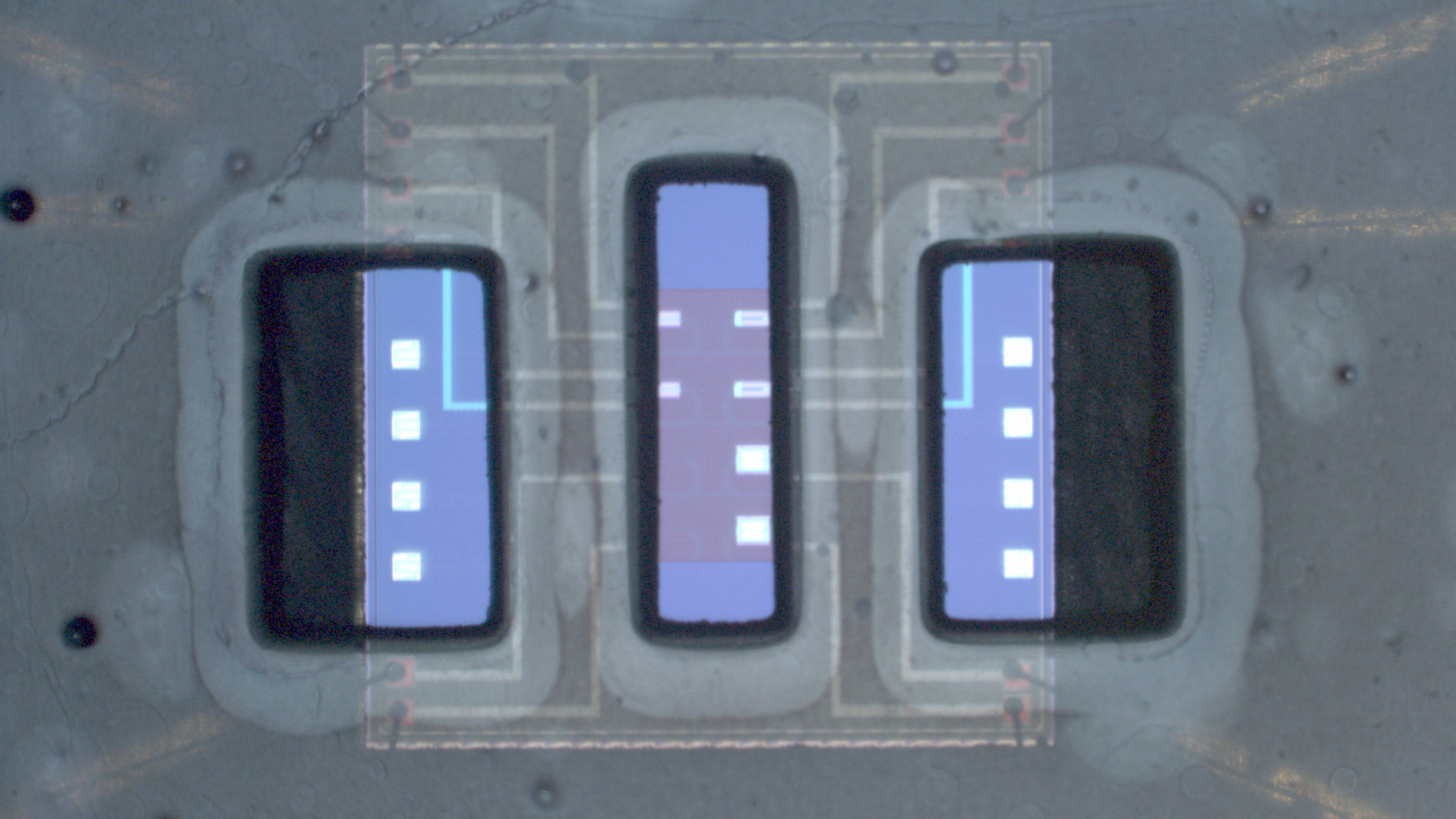Microelectronics is playing an increasingly important role in biotechnology. Both scientific fields use methods for the manipulation of nanoscale structures, which are constantly being refined. This convergence has led to the formation of the new field of bioelectronics, which deals with the integration of electronic systems in biological environments and investigates interactions between the two worlds of materials. Important developments are currently taking place in the field of electrical cell separation, where progressive miniaturization makes it possible to move and manipulate biological cells by seemingly invisible tweezers.
In order to keep up with this development, TU Berlin and IHP have founded the Joint Lab Bioelectronics.
-
Research >> click here <<
The research focus of the Joint Lab is the development of:
- cell handling by dielectrophoresis
- photonic biosensors
- monitoring of bioprocesses
- additive manufacturing for lab-on-chip systems
Cell Handling by Dielectrophoresis
If biological cells dissolved in an aqueous medium are exposed to inhomogeneous electrical fields, an electric dipole moment can be induced and an interaction with the field is induced. Consequently, a force is exerted on the cell, which is called dielectrophoresis (DEP) or dielectrophoretic effect. The majority of biotechnological investigations in this field involve the manipulation of cell currents in microfluidic channels in which DEP is induced by metallic electrodes. The DEP force may be either attractive or repulsive, depending on whether the cell is attracted to or repelled from the electrode with higher field line density.
Dielectrophoresis is a remarkable phenomenon because it allows to separate different cells according to their different polarizabilities - without marking them as shown in the schematic drawing. The technique has therefore already been tested for the sorting of different E. coli strains or on microorganisms with different densities of cell organelles. Within the Joint Lab its use for the optimization of bioprocesses is being tested [1].
Photonic Biosensors
Bioelectronics also plays an important role in the detection of biological molecules, i.e. in biosensor technology. Different principles like electrochemical, optical, immunological and combinations are conventionally used for this purpose. The decisive advantage of microelectronics lies in the extreme miniaturization of sensor systems that is becoming possible. This is because in recent years, more and more functionalities have been integrated into microchips - as each of us was able to realize from our increasingly smaller smart phones.
Within the framework of a DFG-funded project, an optical biosensor chip is being developed at the Joint Lab, in which the detection is performed by a microring resonators. An optical wave standing in a round waveguide (microring) is modulated by the concentration of the analyte. In the current project, the diffusion of analyte molecules to the microring is enhanced by the attractive DEP effect, thus achieving the smallest detection limits.
The figure schematically shows the sensor design and a scanning electron microscope image (white bar as scale with 10 µm length). The metallic DEP electrodes are designed in a zigzag shape and the exposed area of the microring runs in a trench [3].


Monitoring of bioprocesses
Bioreactors are nowadays used to produce a variety of pharmaceuticals, food supplements and other chemical substances. Monitoring of the process conditions is necessary to keep the processes running stable and effective. For this purpose, physical parameters such as pH and temperature, but also the concentration of certain substances must be continuously monitored.
The most commonly used carbon source in bioprocesses is glucose and a study was conducted to determine the suitability of an affinity viscometric glucose sensor developed at IHP for monitoring glucose in diabetic patients [4]. It was found that the fluctuating electrolyte concentrations can cause a strong drift of the sensor signal. Based on this experience, optical biosensors such as those based on the Raman principle currently seem to be the most suitable for bioprocess monitoring [5].The figure shows the glucose sensor chip tested in a bioprocess.

Additive Manufacturing for Lab-on-Chip
The use of microelectronic chips in biological environments opens up prospects for extensive miniaturization. For various applications, the analyses previously performed in an entire laboratory could be brought together in a very small space, which is why the abbreviation Lab-on-a-Chip (LoC) has become established. In such LoC systems, e.g. cell suspensions are processed in microfluidic channels and directed to microscopically small mixing, lysis and analysis volumes. The latter may be equipped with microelectronic sensor chips, for which special integration or packaging concepts must then be developed.

3D printing or additive manufacturing processes in general have made integration processes much easier. In various projects such as the MRR-DEP biosensor or DEP-based cell separation, the required experimental systems are manufactured using AM processes. For this purpose, use is made of the many possibilities that exist for AM at the TU Berlin. The figure shows the exploded view of a microfluidic system for microalgae separation with the DEP effect [2].
-
Projects >> click here <<
Photonic Biosensor Technology
Cell Separation
-
Publications >> click here <<
-
Henriksson A, Kasper L, Jäger M, Neubauer P, Birkholz M, An Approach to Ring Resonator Biosensing Assisted by Dielectrophoresis: Design, Simulation and Fabrication, Micromachines 2020, 11(11), 954.
-
V. Abt, F. Gringel, A. Han, P. Neubauer, M. Birkholz, Separation, Characterization, and Handling of Microalgae by Dielectrophoresis, Microorganisms 8 (2020) 540
-
A. Barai, J. Flügge, A. Hutari, P. Neubauer, M. Birkholz, Dielektrophorese-basiertes Lab-on-Chip-System zur Separation von Mikroalgen, Mikrosystemtechnik-Kongreß, Berlin, 2019
-
A. Henriksson, L. Kasper, M. Jäger, P. Neubauer, M. Birkholz, An approach to ring resonator biosensing assisted by dielectrophoresis: Design, simulation and fabrication (submitted) 2020
-
L. Theuer, M. Lehmann, S. Junne, P. Neubauer, M. Birkholz, Micro-electromechanical affinity sensor for the monitoring of glucose in bioprocess media, International journal of molecular sciences 18 (2017) 1235
-
M. Kögler, A. Paul, E. Anane, M. Birkholz, A. Bunker, T. Viitala, M. Maiwald, S. Junne, P. Neubauer, Comparison of time‐gated surface‐enhanced raman spectroscopy (TG‐SERS) and classical SERS based monitoring of Escherichia coli cultivation samples, Biotechnology Progress 34 (2018), 1533
-
-
Education >> click here <<
The integrated course "Introduction to Bioelectronics" is held regularly in the summer semester at TU Berlin. It is primarily aimed at biotechnologists (and students of other life sciences) to familiarize them with modern methods of microelectronics.
Since 2019, a practical course in bioelectronics is also offered, which includes experiments on ECG, amperometric glucose sensors, dielectrophoresis and cell density determination by impedance measurement.
Various BSc and MSc theses have been jointly supervised since the Joint Lab was established.





